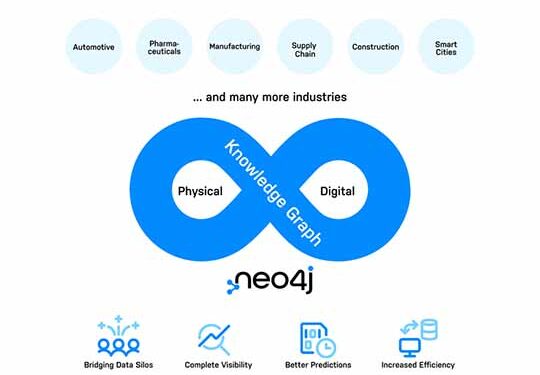SAN MATEO, Calif. : – Neo4j announced a sharp increase in demand for graph technology for digital twins. Organizations are leveraging graph technology to build large-scale digital twins capable of unifying data across disparate sources, delivering rich analytics, and supporting near real-time monitoring of critical assets.
In 2022, the digital twin market size was valued at $6.9 billion and is projected to reach $73.5 billion by 2027. Further, Gartner predicts that by 2025, 25 global enterprises will achieve $1 billion in revenue or cost savings from their digital twin initiatives, up from one in 2021. Source: Gartner, Emerging Technologies: Revenue Opportunity Projection of Digital Twins, Alfonso Velosa et al.,16 Feb 2022. While the value of digital twins is compelling, the scope of effort required to create them can be daunting. An effective digital twin is created from massive volumes of disparate data from many sources and in many formats, incorporating elements such as 3D models, accounting systems, and operational systems, as well as data from IoT devices.
A knowledge graph excels at harmonizing complex data and flexibly modeling massive real-world structures and their business logic. With Neo4j’s graph database at the foundation, organizations can manifest a digital twin in any structure or process within any industry, leading to a wide variety of use cases. Neo4j’s graph data platform provides the flexibility, performance, and analytical capabilities needed to build, manage, and query digital twins on an enterprise scale economically, unifying data across myriad sources to provide the most business value. Graphs bring the most advanced analytics to digital twins and support powerful queries, as well as data science and machine learning techniques from algorithms to embeddings.
Maya Natarajan, Senior Director of Product Marketing at Neo4j, emphasized the value digital twin technologies unlock and bring to a wide range of industries.
“While the technology for digital twins is only just emerging, it is quickly becoming popular in corporate strategy, giving us the power to understand the present and predict the future,” says Natarajan. “Today, we can use digital twins to create digitized model simulations of all parts of our businesses, from supply chains to HR systems, auto manufacturing, and more. With digital twin deployed to its full potential with graph technology, organizations can enable a new, intelligent, resilient capability and ultimately gain the most business value.”
Neo4j Digital Twin Customer Success
Customers use Neo4j graph technology to help build cutting-edge digital twins across various industries and use cases. Digital twins for supply chain offer visibility into complex networks, connect diverse product validation life cycle data for automotive, and mirror complex production lines in life sciences manufacturing.
Organizations that have implemented Neo4j graph technology as part of their digital twin initiative are well-positioned for agility. Here are some examples of how they use Neo4j to advance critical initiatives:
According to Dave Rich, Head of Enterprise Architecture and IT Services at CSX Transportation, leading supplier of rail-based freight transportation in North America, Neo4j was chosen to help them build a digital twin model of their physical network.
“We quickly recognized that the problem we needed to solve was based on connections – gaining a stronger understanding of the complex relationships between assets such as locomotives, rail cars, customers, shipping orders, mileposts, and more,” said Rich. “With Neo4j, we’ve been able to efficiently track, report, and visualize hundreds of thousands of assets and the interrelationships over time, and how they transpire. This digital twin has also given our customers visibility into where their orders are and when they will arrive, improving that side of business as well.”Turku City Data uses a “Smart City Knowledge Graph” to support its digital twin to address key city priorities such as reducing energy usage and finding routes that optimize delivery speed and transportation resources.
Neanex offers digital twin services built on Neo4j that empower asset owners to create a digital twin that connects all types of data, from 3D models to building permits.
A large global F100 pharmaceutical company has implemented a Neo4j-powered digital twin to support a broad range of supply chain use cases from simulations for decision-making, optimizations on parameters such as cost and time, risk assessment and mitigation, and production line design alternatives. By combining the power of graph technology and digital twins, organizations gain a unique competitive advantage. As the world’s digital landscape expands, these virtual equivalents will prove ever more important in devising optimal solutions that were previously inconceivable.
For More Information
To learn more about how organizations leverage Neo4j for digital twins, watch “Building the Rail Network Digital Twin at CSX” and “Optimize Your Supply Chain with Knowledge Graphs, IoT, and Digital Twins,” an on-demand webinar on how knowledge graphs underpin digital twins for supply chain management.
Resources














